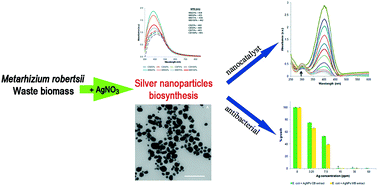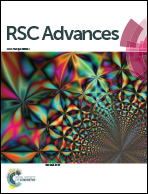Synthesis of silver nanoparticles from Metarhizium robertsii waste biomass extract after nonylphenol degradation, and their antimicrobial and catalytic potential†
Abstract
Microorganisms are commonly applied to remove toxic compounds from the contaminated environment. Decontamination processes result in the generation of large amounts of biomass waste, whose disposal still remains a problem. Biomass waste is a very good source of various organic and inorganic substances, and it can be further used in many processes. In this study, an innovative approach, synthesis of silver nanoparticles (AgNPs) from biomass waste obtained from the filamentous fungus Metarhizium robertsii after nonylphenol degradation, was applied using different biomass extract contents (25, 50, 75 and 100%). The highest reduction rates were noted for diluted samples (25 and 50%) and photoinduction allowed reduction of the time required for synthesis to 3 h. AgNP synthesis from waste biomass extracts was not only more efficient compared to the control biomass extract, but also the obtained nanoparticles were smaller, more homogenous in size and predominantly spherical, which makes them more applicable for medical or catalytic purposes. FT-IR and XPS analyses revealed the protein involvement in AgNP synthesis. The studies conducted with the application of enzyme inhibitors pointed to the enzyme being engaged in AgNP synthesis, while the amounts of capping agents present in nanoparticles were determined by thermogravimetric analysis. AgNPs formed from waste biomass extract express not only high biocatalytic activity in toxic compound degradation (e.g. nitrophenol and methylene blue), but also possess antimicrobial activity against Gram-positive and Gram-negative bacteria and can be applied as an effective biocatalyst or for medical purposes.


 Please wait while we load your content...
Please wait while we load your content...